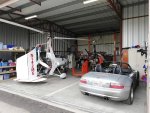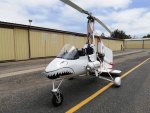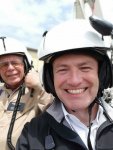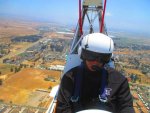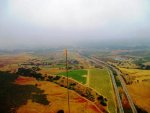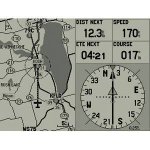- Joined
- Oct 30, 2003
- Messages
- 18,378
- Location
- Santa Maria, California
- Aircraft
- Givens Predator
- Total Flight Time
- 2600+ in rotorcraft
I love how passion for gyroplanes transcends borders, language and culture.
Gerhard was going to be in California briefly visiting from Switzerland and wanted to stop by because of reading my posts on Facebook. He is a licensed gyroplane pilot in Germany and has had a business relationship with AutoGyro GMBH; the largest producer of gyroplanes in the world.
I could tell quickly on the phone that Gerhard was someone I would like to spend time with and he was gracious when I explained I could not give him flight instruction without going through the Transportation Security Administration because he was not a citizen of the USA. They suggest the process takes six weeks so there was simply not enough time. Gerhard would like to get an FAA gyroplane pilot certificate and I explained the avenues available to him.
Gerhard was punctual and I let him in the gate when I received his call. The hangar was a little full with the addition of Robert’s aircraft and we had an interesting, animated conversation till we began to see patches of blue.
Gerhard’s enthusiasm for flying gyroplanes was infectious and his imagination wondrous. He expressed some ideas about selling gyroplanes that seemed clever and workable to me.
The local weather was very much “June Gloom” making a flight up the beach impractical. Gerhard didn’t want to miss the opportunity to fly a gyroplane in California so we decided to fly to San Luis Obispo direct (SBP) weather permitting.
I checked the weather and Santa Maria (SMX) had nine miles visibility with the ceiling at 1,200 feet and SBP had seven miles visibility and the ceiling was 1,400 overcast. Visual Flight Rules minimums are three miles and 1,000 feet so we were legal but it was probably not smart with my judgement being clouded by the narrow window of opportunity and Gerhard’s strong desire to fly.
San Luis Obispo is twenty two nautical miles North West of SMX if you fly direct and I fly there often so I am familiar with the geographical features as seen from the air although I seldom fly direct to anywhere.
I called the SBP air traffic control 13 miles to the South East at 1,200 feet with information Romeo; inbound to land. I was to fly direct to runway two niner remaining south of the centerline and report four miles.
At seven miles out I was made aware of some faster traffic at my four o’clock high that would pass off to my right. My panel powered GPS went blank (blew a fuse and the batteries went dead) and I realized I did not have the airport in sight. The Edna Valley looks different shrouded in mist and I let the tower know I was not sure of my position and did not have the airport in sight. I looked at the chart but it was not much help.
The faster plane passed high off to my right and I reported him in sight.
I could see I was putting together the links of a classic accident chain and preparing to turn around just as I identified the airport. I was still about six miles out and reported; “airport in sight”. The tower shot back; “Gyroplane 142 Mike Golf; Runway Two Niner Clear to Land.”
We had a lovely lunch and the flight back was uneventful.
For those unfamiliar; the mistakes I made were:
Plan B would have been turn around and follow highway 101 back to SMX.
Plan C would have been to fly to Taft to get away from the coastal fog and we had enough fuel on board for plan C.
I share this experience in the hopes it will allow others to recognize and break the accident chain before it becomes an NTSB report. For most accidents the accident chain is begins before flight.
Gerhard seemed undaunted by my mistakes and I very much enjoyed his visit and our flight together. I look forward to our ongoing friendship.
Gerhard was going to be in California briefly visiting from Switzerland and wanted to stop by because of reading my posts on Facebook. He is a licensed gyroplane pilot in Germany and has had a business relationship with AutoGyro GMBH; the largest producer of gyroplanes in the world.
I could tell quickly on the phone that Gerhard was someone I would like to spend time with and he was gracious when I explained I could not give him flight instruction without going through the Transportation Security Administration because he was not a citizen of the USA. They suggest the process takes six weeks so there was simply not enough time. Gerhard would like to get an FAA gyroplane pilot certificate and I explained the avenues available to him.
Gerhard was punctual and I let him in the gate when I received his call. The hangar was a little full with the addition of Robert’s aircraft and we had an interesting, animated conversation till we began to see patches of blue.
Gerhard’s enthusiasm for flying gyroplanes was infectious and his imagination wondrous. He expressed some ideas about selling gyroplanes that seemed clever and workable to me.
The local weather was very much “June Gloom” making a flight up the beach impractical. Gerhard didn’t want to miss the opportunity to fly a gyroplane in California so we decided to fly to San Luis Obispo direct (SBP) weather permitting.
I checked the weather and Santa Maria (SMX) had nine miles visibility with the ceiling at 1,200 feet and SBP had seven miles visibility and the ceiling was 1,400 overcast. Visual Flight Rules minimums are three miles and 1,000 feet so we were legal but it was probably not smart with my judgement being clouded by the narrow window of opportunity and Gerhard’s strong desire to fly.
San Luis Obispo is twenty two nautical miles North West of SMX if you fly direct and I fly there often so I am familiar with the geographical features as seen from the air although I seldom fly direct to anywhere.
I called the SBP air traffic control 13 miles to the South East at 1,200 feet with information Romeo; inbound to land. I was to fly direct to runway two niner remaining south of the centerline and report four miles.
At seven miles out I was made aware of some faster traffic at my four o’clock high that would pass off to my right. My panel powered GPS went blank (blew a fuse and the batteries went dead) and I realized I did not have the airport in sight. The Edna Valley looks different shrouded in mist and I let the tower know I was not sure of my position and did not have the airport in sight. I looked at the chart but it was not much help.
The faster plane passed high off to my right and I reported him in sight.
I could see I was putting together the links of a classic accident chain and preparing to turn around just as I identified the airport. I was still about six miles out and reported; “airport in sight”. The tower shot back; “Gyroplane 142 Mike Golf; Runway Two Niner Clear to Land.”
We had a lovely lunch and the flight back was uneventful.
For those unfamiliar; the mistakes I made were:
- Anxious to fly because of Gerhard’s limited window of opportunity.
- Overconfidence because of my familiarity with the route, local weather and the aircraft.
- Marginal weather with near minimum VFR conditions at both the departure airport and the destination airport.
- Equipment failure; The GPS is not my primary navigation. It is useful when describing my location to ATC.
- I was not able to use the chart effectively because of our low altitude and the mist.
Plan B would have been turn around and follow highway 101 back to SMX.
Plan C would have been to fly to Taft to get away from the coastal fog and we had enough fuel on board for plan C.
I share this experience in the hopes it will allow others to recognize and break the accident chain before it becomes an NTSB report. For most accidents the accident chain is begins before flight.
Gerhard seemed undaunted by my mistakes and I very much enjoyed his visit and our flight together. I look forward to our ongoing friendship.

